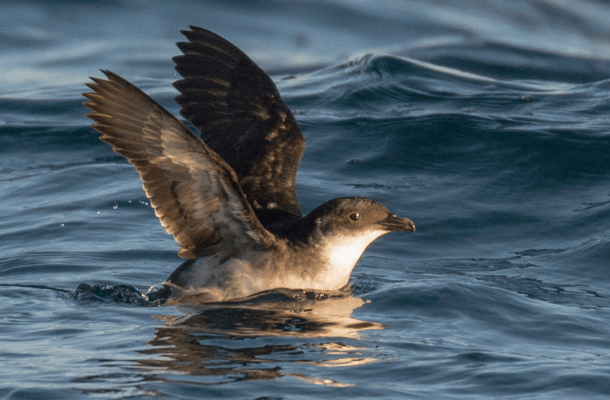Peruvian Diving-petrel Downlisted

The Peruvian Diving-petrel population has recovered enough to be downlisted by the IUCN. Photo by Rodrigo González Pairoa
The Peruvian Diving-petrel, previously considered Endangered by the International Union for Conservation of Nature (IUCN), has been downlisted from Endangered to Near Threatened as the population resurges following conservation interventions on Choros and Chañaral Islands in the Humboldt Penguin National Reserve, Chile.
A small, burrow-nesting seabird, the Peruvian Diving-petrel historically bred on 13 islands in Peru and Chile, where it is known as the potoyunco and yunco, respectively. Devastated by introduced, nonnative invasive species, habitat destruction from guano extraction, and poaching, the population plummeted, putting the species at risk of global extinction.
For over a century, invasive European Rabbits decimated the sensitive desert landscape of Choros and Chañaral — stripping bare herbs and shrubs, and occupying diving-petrel nesting burrows. Chañaral Island once supported the world's largest Peruvian Diving-petrel population, thought to be over 100,000 pairs, but the birds were driven out by the rabbits. Choros remained the only breeding colony within the Humboldt Penguin National Reserve. Starting in 2013, the Chilean National Forestry Corporation (CONAF), in collaboration with Island Conservation, set out to protect diving-petrels and other threatened species by removing rabbits from both islands.
Success on Choros was almost immediately evident, as the fields and hillsides became blanketed with native plant seedlings, and Peruvian Diving-petrels began seeking out burrows formerly taken over by rabbits. Five years later, biologists returned to Choros and documented that the breeding area had doubled in size, with more than three times as many sub-colonies compared to when invasive rabbits were present. The IUCN's 2020 evaluation of the Peruvian Diving-petrel noted this rapid population recovery as part of the justification for downlisting the species.
Coral Wolf, Conservation Program Manager at Island Conservation, who led the monitoring trip, notes, “Restoration of Choros was expected to increase the Peruvian Diving-petrel population, but the extent to which they would recover was unknowable. We are thrilled to see that by eliminating resource competition with invasive rabbits, the population has expanded, supporting the overall resilience of this species to the impacts of climate change scenarios and other threats.”
The partners, with support from American Bird Conservancy and others, are now focused on re-establishing diving-petrel breeding colonies on Chañaral by implementing a social attraction project. Using looped recordings of petrel calls from Choros, played over speakers alongside artificial burrows, the team hopes to attract breeding-age birds seeking out nesting habitat. The project has already shown tremendous potential, with up to three petrels observed in a camera-trap photo and some seen entering the artificial burrows.
“Clearly there are adult diving-petrels out there looking for suitable nesting habitat,” says George Wallace, ABC's Director of International Programs and Partnerships. “It is exciting to imagine that Chañaral, once home to the largest diving-petrel colony, is on the road to recovery.”
IUCN still considers invasive species, habitat destruction, and climate change ongoing threats to the species, but recognizes the successful restoration of Choros and Chañaral and the social attraction program as contributing factors in the population's progressive recovery. Looking to the future, multiple opportunities exist in Chile and Peru for invasive species eradication on historic, potential, and confirmed Peruvian Diving-petrel breeding islands. One such potential restoration project is on Islas Vieja and Gallán in Peru's Paracas National Reserve, home to existing diving-petrel colonies. There, ABC is lending support to research conducted by the Universidad Cientifica del Sur that may result in a project to rid the islands of invasive, nonnative House Mice.
Support for ABC-funded components of this work comes from the estate of Mary Janvrin.
This piece has been modified and was in conjunction with Island Conservation. To see more, please visit their press release webpage.
###
Media Contact: Jordan Rutter, Director of Public Relations, 202-888-7472 | jerutter@abcbirds.org | @JERutter
Expert Contact: George Wallace, Director of International Programs and Partnerships | gwallace@abcbirds.org
American Bird Conservancy is a nonprofit organization dedicated to conserving wild birds and their habitats throughout the Americas. With an emphasis on achieving results and working in partnership, we take on the greatest problems facing birds today, innovating and building on rapid advancements in science to halt extinctions, protect habitats, eliminate threats, and build capacity for bird conservation. Find us on abcbirds.org, Facebook, Instagram, and Twitter (@ABCbirds).


















































